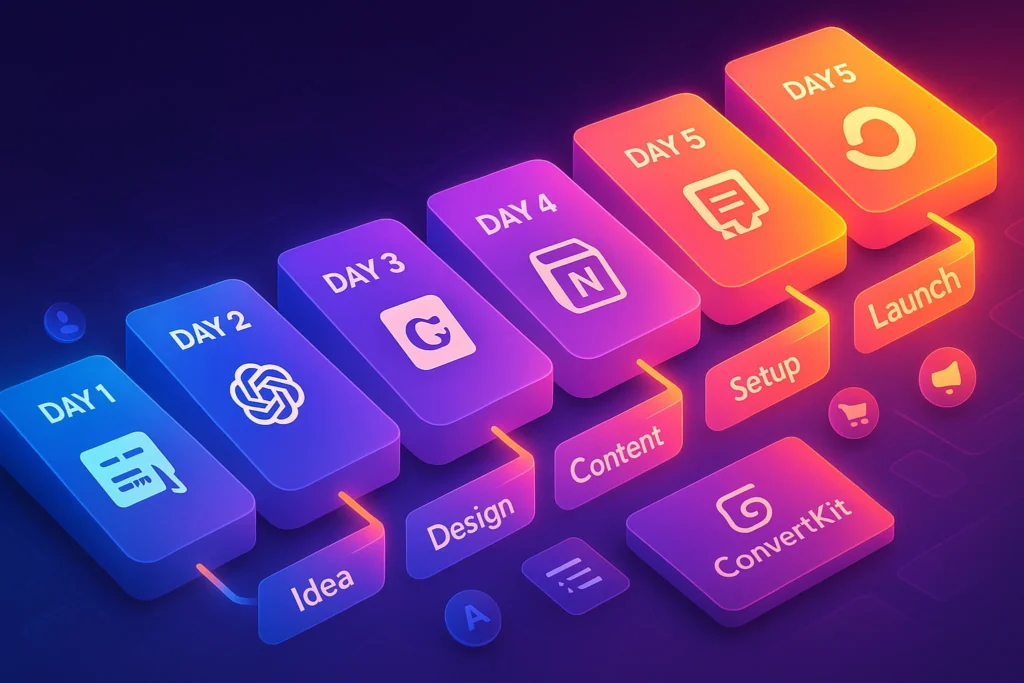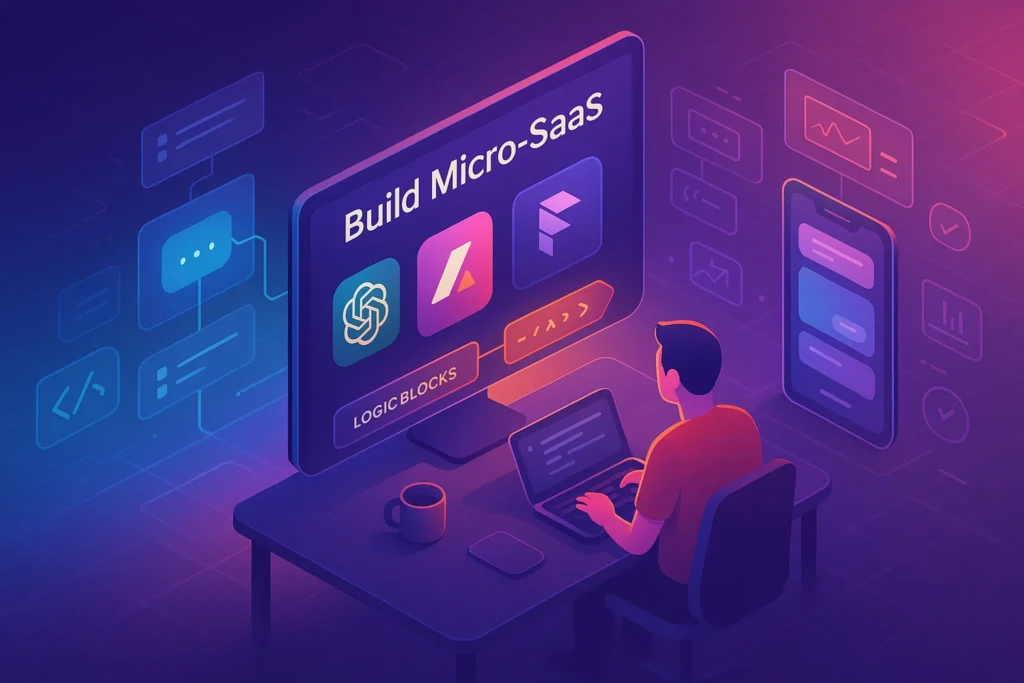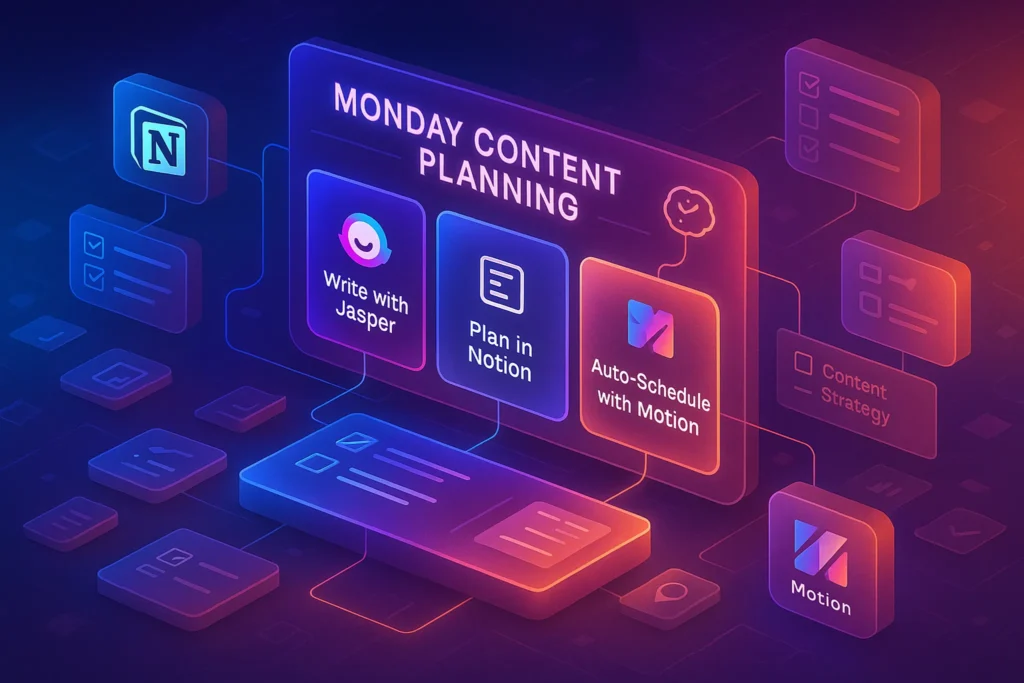-This post may contain affiliate links. If you click on one and make a purchase, I may earn a small commission at no extra cost to you.-
🧠 Introduction – Why You Should Launch Fast, Smart, and with AI
Digital products offer high leverage—create once, sell forever. But many creators stall trying to perfect every detail. That’s where AI comes in. With smart tools, you can shape ideas, outline content, write, design, and launch in just 7 days ✅.
Whether you’re a solopreneur, digital nomad, or curiosity-driven creator, this step-by-step plan takes you from zero to launch without burnout or complexity. Plus, it complements your workflow—especially if you’re already using productivity enhancers like Best Smart Calendar Apps for Productivity (+ AI Features) for time-blocked creation.
🧩 Day 1: Ideation & Product Planning
Deep Dive:
Start by pinpointing a specific problem your audience faces. Ask yourself: what pain am I solving in under 7 pages or a 30-minute course? Use ChatGPT or Bard prompts like:
“I’m a digital nomad who struggles with staying organized across time zones. Suggest eBook or mini-course topics I could create in seven days.”
Gather 10–12 ideas, then filter them using your rubric:
-
Relevance – Does the topic address a pain point your audience is already searching for?
-
Speed – Is it feasible to develop a polished digital product in seven days?
-
Monetizability – Can you charge at least $9+ for this?
-
Evergreen Potential – Will it remain relevant for months or even years?
Once you pick your idea—for example: *“A productivity checklist for digital nomads”—identify the core outcome (e.g., “Boost focus by 3X in new environments”).
Planning Template:
-
Product type? (eBook, template, mini-course)
-
Format outline? (length, delivery)
-
Launch goal? (e.g., 100 sales × $15)
-
Write 3–4 SMART goals: what exactly you’ll achieve each day.
🔍 Goal: Choose a digital product that fits your skills & audience.
-
ChatGPT Brainstorm:
Prompt: “Ideas for a 5-page ebook that helps [audience] solve [problem]”
Generate 10 ideas and shortlist 1–2 based on:-
Viability (solves a real problem)
-
Format (quick to build in 7 days)
-
Marketability (low competition)
-
-
Reverse‑Engineer a Structure:
Use ChatGPT to outline the main deliverables.
Decide: ebook, checklist, template, or mini‑course? -
Set Your Outcome & Metrics:
Example: launch a $9 ebook, aim for 100 copies = $900 revenue.
Set work blocks in your smart calendar for consistency.
🛠️ Day 2: Outline / Table of Contents
Deep Dive:
Turn your topic into a structured flow. Start with high-level headings:
1. Understanding Your Context (Why location switching disrupts focus)
2. Essential Tools for Nomadic Productivity
3. Daily Routine Framework
4. On-the-Go Workspace Setup
5. Minimizing Distractions While Traveling
6. Scaling up: Templates & Repeatable Systems
7. Bonus: Quick Start Action Plan
Paste those into Notion, then use Notion’s AI feature to expand each heading into summary paragraphs that answer “What this section will teach.” For example:
“In Section 3, you’ll learn how to build a daily ‘power hour’ ritual, leveraging sunrise-based scheduling and Pomodoro techniques specific to mobile lifestyles.”
Add clarity by listing 3–5 bullet points underneath each summary (these will feed into your drafts on Day 3).
End the day with a polished finalized outline—linked to each chapter in Notion with placeholder content, ready for writing.
🔍 Goal: Build a clear, structured product outline.
-
Generate TOC with ChatGPT:
-
Input your chosen idea; ask for 5–7 chapter or section titles.
-
Turn them into bullet-point subheadings (mini lessons).
-
-
Refine with Notion AI:
-
Paste ChatGPT output into Notion.
-
Use AI to expand each section into short paragraph summaries (3–4 lines).
-
-
Add Key Goals:
-
For each section, list what the learner or reader will gain.
-
📝 Day 3: Content Drafting
Deep Dive:
Now you write. Feed each section’s summary back into ChatGPT with prompts like:
“Write a 200-word explanation about travel-triggered distraction and how to combat it with digital boundaries.”
Use your brand voice—add your personal insights, a quick anecdote (“I once worked from six time zones in ten days…”), or actionable tips.
Next, combine segments: follow up with prompts such as:
“Expand this section with a step-by-step system and at least two examples of environments to apply it.”
Write daily chunks in batches—draft two sections at once, then lightly adjust each section to sound cohesive.
By end of Day 3, aim for a 3,000–4,000 word draft—5–6 openings fully built out, with the intro and conclusion scaffolded.
🔍 Goal: Generate raw content that aligns with voice & objectives.
-
Co-Writing Using ChatGPT / Jasper:
-
Provide brief intros, length targets, and tone direction.
-
Ask for practical examples, case studies, or templates.
-
-
Enhance Originality:
-
Add personal insights, stats, or quotes—avoid “machine-only” tone.
-
Mix AI with your voice to keep authenticity.
-
-
Speed Tip:
Use sections in parallel—ChatGPT drafts section 1 while your voice polishes section 2.
📚 Day 4: Editing & Formatting
Deep Dive:
Clean your draft thoroughly. Copy each section into Grammarly to polish grammar and flow. Then pass it through Hemingway Editor for readability—target a 4th–6th grade level to ensure clarity.
Split long paragraphs. Reformat to:
-
Intro block with hook + promise
-
Main copy – subheadings for step progression
-
Action callout – bold or box with key takeaway
-
Transition sentence – connects to next part
Use Wordtune’s “Rewrite” feature to ensure sentences are varied and compelling.
Finally, craft your Introduction (lead with the problem, forecast the plan) and Conclusion (clarify big wins and next steps). It should flow naturally into Day 5’s design phase.
🔍 Goal: Clean text, refine tone, and ensure readability.
-
Grammar & Flow with Grammarly / Wordtune:
-
Correct errors and polish word choice.
-
Use “Rewrite” suggestions for variety.
-
-
Readability & Structure:
-
Run through Hemingway Editor (highlight simple sentences).
-
Adjust paragraphs to 3–4 lines max.
-
Add subheadings, bullet lists, or call-out boxes.
-
-
Convert to Final Format:
-
For ebooks, use Notion or Google Docs templates.
-
For templates, design spaces for user input.
-
For courses, script video/audio segments.
-
🖼️ Day 5: Design & Templates
Deep Dive:
Make your content visually engaging:
-
In Canva:
-
Create a branded cover using custom fonts/colors.
-
Design page header formats and box templates (e.g. “Tip Box,” “Pro Tip,” “Checklist Step”).
-
Save templates for easy reuse and adjust colors/branding for consistency.
-
-
For mini-courses:
-
Use Figma’s AI plugin (like “Magical Design”) to layout screencast templates (e.g., prompt screenshot, script bullet).
-
Export slides as images or embed Loom video links.
-
Your output: a polished PDF or template pack with clickable Table of Contents.
🔍 Goal: Make your product visually appealing and usable.
-
Cover & Page Design with Canva + Magic Studio:
-
Use AI-powered tools for matching visuals and brand fonts.
-
Export high-res JPG/PDF for ebooks.
-
-
Templates with Figma AI Plugins:
-
Create fill-in templates users can duplicate.
-
Customize fields and download as PDF.
-
-
Mini-Course Assets:
-
Use screenshot tools, UI captures, or embed Loom walkthrough videos.
-
Maintain a consistent style and branding.
-
💡 Day 6: Build Sales Page & Pricing
Deep Dive:
Now you write copy that makes your product irresistible:
-
Use AI-powered copy tools (Copy.ai, Writesonic) with prompts like:
“Write a 5-sentence landing page intro for a digital nomad productivity checklist.”
Derive bullet points from your content outline: each bullet becomes a feature/benefit statement.
-
Scroll past competitor pages and run them through ChatGPT to inspire better headlines and clarity.
-
Design your page layout:
-
Header with image + headline
-
Feature section with icons and benefit bullets
-
Social proof block (e.g., “Beta readers increased productivity by 50%”)
-
Price section with CTA button
-
-
Set your price:
-
Start at $9–$27 for checklists; $49–$97 for mini-courses
-
Add urgency (e.g. “Early adopter bonus”), time-sensitive pricing, or limited-seat offers.
-
Integration:
-
Link via Gumroad or Payhip—upload product and asset files.
-
Set up Stripe for payments.
-
Create step-by-step delivery page with bonus download links.
🔍 Goal: Craft a sales page that converts.
-
Use AI to Write Copy:
-
Prompt Copy.ai or Writesonic for headline, features, testimonials, CTAs.
-
Pull direct quotes from you or beta readers.
-
-
Choose Platform & Layout:
-
Tools like Gumroad, Payhip, or Shopify embedded on your site.
-
-
Create Pricing Strategy:
-
Base pricing on value + comparable digital products.
-
Offer low-risk options: Launch early-bird, limited-time offer, or bundle upsell.
-
-
Set Up Delivery & Payment:
-
Bundle download options, templates, or course access.
-
Configure thank you page and upsell link.
-
🚀 Day 7: Launch + Promotion
Deep Dive:
Launch day! Here’s your blueprint:
-
Email sequence (via ConvertKit / MailerLite):
-
Email 1: “📢 It’s Live—Download Now!” with CTA
-
Email 2 (Day 3): “How to get the most out of your product”
-
Email 3 (Day 6): “Last chance for early-bird bonus”
-
Use emotional and social hooks (“Why I walked away from $5K monthly retainer to teach this system”).
-
Social media posts:
-
X thread: Map your 7-day build story — from idea to launch with earnings numbers.
-
Carousel on LinkedIn or Instagram: 7 visuals, one for each day, with tips + link.
-
-
Repurpose micro-content:
-
Use ThreadReader or embed visuals from your Canva templates
-
Pull tip statements for tweets, and insert a launch link
-
-
Community engagement:
-
Daily Reddit update on your build (r/Entrepreneur, r/digital_nomad)
-
Encourage feedback in comments or replies
-
🔍 Goal: Publish and drive traction immediately.
-
Publish + Email Launch:
-
Use your email tool (ConvertKit, MailerLite) to send launch sequence.
-
Offer special day-one discount or announcement.
-
-
Social Sharing & Repurposing:
-
Schedule posts using Buffer or Hootsuite.
-
Repurpose content:
-
Tweet thread: Key insights or steps
-
Instagram carousel: Share your creation journey
-
LinkedIn post series: Mini chapters with engagement hooks
-
-
-
Leverage Communities:
-
Share in relevant Subreddits, Facebook groups, IndieHackers.
-
Offer affiliate or referral discounts for early users.
-
🔁 Bonus: Smart Scheduling Integration
Building a 7-day launch plan benefits from time-blocking and reminders—especially if you use smart calendar tools like those discussed in Best Smart Calendar Apps for Productivity (+ AI Features). Schedule rigorous, focused work blocks (e.g., 90-minute sprints) to maintain momentum.
🗓️ 7‑Day Plan Overview
| Day | Focus | AI Tools Suggested |
|---|---|---|
| 1 | Ideation & Product Planning | ChatGPT, Google Bard |
| 2 | Outline / Table of Contents | ChatGPT, Notion AI |
| 3 | Content Drafting | ChatGPT, Jasper, Sudowrite |
| 4 | Editing & Formatting | Grammarly, Wordtune, Hemingway Editor |
| 5 | Design & Templates | Canva + Magic Studio, Figma AI plugins |
| 6 | Build Sales Page & Price | Copy.ai / Writesonic, ConvertKit, MailerLite |
| 7 | Launch + Promotion | Buffer, Hootsuite, Lanza AI, ChatGPT for email |
🛠️ Quick Integrations Checklist
-
Kanban Tracking: Use Trello or Notion to track daily steps.
-
Smart Calendar Setup: Time-block each day in your apps like explained in Top Smart Calendar Apps.
-
Template Automation: Use Tally or Jotform to receive order info and deliver access.
❓ Frequently Asked Questions
Q1: What if I can’t finish in 7 days?
→ Break steps in half-days or extend to 10 days—flexibility keeps momentum.
Q2: What formats should I start with?
→ Start small—ebooks or click-and-use templates are lowest resistance. Expand to mini-courses later.
Q3: How do I price it without undercharging?
→ Price based on outcome (e.g., $9–$27 for simple templates, $49–$97 for mini-courses). Test with an early-bird launch.
Q4: Do I need a website to sell?
→ No—platforms like Gumroad or Payhip let you sell with no-code checkout pages.
Q5: Can I launch again or iterate?
→ Definitely! Use feedback to improve and launch Version 2 with added bonuses or video.
💬 Would You Bite?
What kind of product do you want to build—eBook, checklist, workbook, or mini-course?
Drop a 🔥 below, and I’ll help you outline it (or give you a starter template)! 👇



